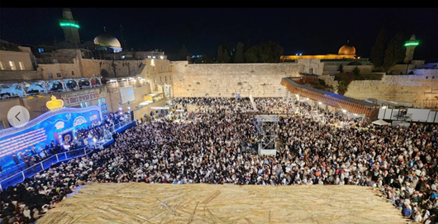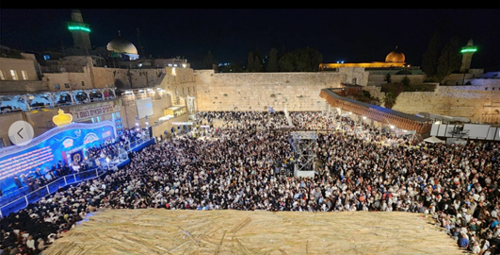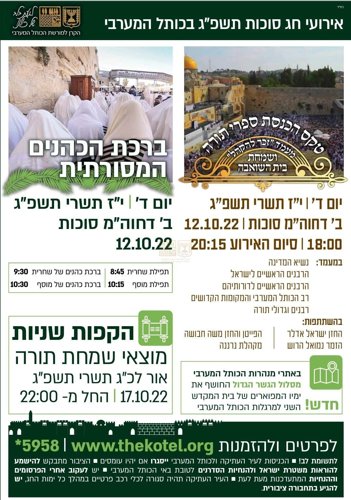Hakhel Sukkot 5783

Description of the exciting event of Zecher LeHakhel, that took place at the Kotel during Sukkut 5783
Every seven years, on Sukkot immediately following shemitah, the Torah commands us to perform the mitzvah of hakhel. This mitzvah obligates everyone: men, women, and children and it takes place on Sukkot because then the entire Jewish People are already gathered in Jerusalem during their Sukkot pilgrimage. In this way it is possible to perform the mitzvah by the masses.
Hakhel took place at the Beit Hamikdash: the king would read sections from the book of Devarim and would say blessings over the Torah, pray for the Beit Hamikdash, the people, and the kohanim.
One of the goals of this mitzvah is to highlight the unique status of the Jewish People as the Chosen People and impress upon them the essence of the Torah and the impact it has on the entire nation. In the words of Sefer Hachinuch (recording hakhel as the penultimate mitzvah): "Because this mitzvah is a strong pillar and great honor for the religion."
Hakhel 5783
This year, in commemoration of the awe-inspiring event, three Torah scrolls were dedicated at the Western Wall plaza followed by a simchat beit hasho'evah celebration. The event took place on the second day of chol hamo'ed (Wednesday, 17 Tishrei 5783) at 18:00.
Participants included Israel's president, the Chief Rabbis past and present, the Rabbi of the Western Wall and Holy Sites, and other rabbis and dignitaries.
The event was accompanied by Cantor Yisrael Adler, paytan and cantor Moshe Havusha, singer Nemuel Harosh, and the Neranena Choir. See https://thekotel.org/en/129292/.
According to the Western Wall Heritage Foundation, approximately 50,000 were in attendance. See Arutz 7 coverage of the event here (Hebrew).

Israel's president, Isaac (Bougie) Herzog participated in the event and opened it. He recited Psalm 122 and chanted the hafatrah (in an Ashkenazic cantillation) of Isaiah 52:7-12, the end of the haftarah of parashat Shoftim. His grandfather, Rabbi Dr. Yitzchak Herzog, founded the very first event in commemoration of hakhel in 5706 (1946) and 5713 (1953) as the Ashkenazi chief rabbi. His father, President Haim Herzog, read from the Torah at the zecher lehakhel ceremony in 5748 (1988).
Event emcee: Mordechai Soli Eliav, director general of the Western Wall Heritage Foundation.
Moshe Leon was honored with opening the Aharon Kodesh.
Former chief rabbi Yisrael Meir Lau read from the first Torah scroll the opening of the book of Devarim (1:1-15).
Former Sephardic chief rabbi and current rabbi of Jerusalem, Rabbi Shlomo Amar, read from the second Torah scroll parashat shema (Devarim 5:4-9). After him, former Ashkenazi chief rabbi, Rabbi Yonah Metzger, read from parashat Ekev (7:12-15).
Finally, Rabbi David Lau, current Ashkenazi chief rabbi, read parashat hakhel (31:10-13) from the third Torah scroll.
Head of opposition, MK Binyamin Netanyahu was honored with hagbah for the third Torah scroll. Rabbi Haim Drukman recited the blessing for the wellbeing of the State of Israel, followed by Rabbi Rami Berachyahu, rabbi of the Israel Police Force, who recited the blessing for the IDF and Security Forces.
Other dignitaries in attendance included: Rabbi Yehuda Deri, rabbi of Be'ersheva (honored with hagbah for the second Torah scroll), Rabbi Shmuel Rabinowitz, rabbi of the Western Wall and holy sites, and other rabbis. Thomas Nides, the American ambassador also attended the event.
Rabbi Yitzhak Yosef, the Sephardi chief rabbi, did not attend the event. (Although he did in seven years ago. Some believe it is in protest against President Herzog, who the day before visited a sukkah of the Conservative Movement in Ra'anana and right afterwards came to visit the sukkot of Rabbi Yitzhak Yosef and Rabbi David Lau. The president even posted the three pictures together).





